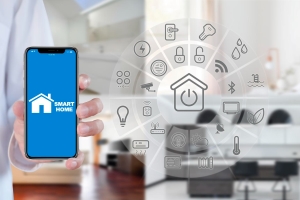Matter is an industry-unifying IoT wireless network standard that still needs to be released. It strives to become a reliant, frictionless, safe communication basis for connected objects. The project was announced and started in 2019. By utilising a specific collection of IP-based networking technologies, initiating with Thread, wi-fi, and Ethernet, Matter is a platform built on IP (Internet Protocol) that enables communication between smart home devices and ecosystems, says Ritesh Sutaria, director at Prompt Equipments Pvt Ltd.
Matter is simplifying development for manufacturers and improving compatibility and ease of use for customers. It is developed on market-oriented technologies bestowed by businesses throughout the industry and molded in a collaborative and open-source manner with an implementation-first method.
Matter endeavors to build interoperability across smart home devices and the Internet of things (IoT) from various suppliers and lessen vendor fragmentation.
Apple, Google, Amazon, Comcast, and the Zigbee Alliance, which are also known as Connectivity Standards Alliance (CSA), developed and introduced the project group. Huawei, Schneider, IKEA, and Silicon Labs joined the group later. Matter-compatible items and software upgrades for already available products are expected for fall 2022.CSA licenses the Matter standard though the Matter code respiratory is open source under the Apache license.
How matter affects the industry:
Matter either uses wi-fi or Thread for radio communication, where Bluetooth is available for device setup functions. Before Matter came, Zigbee, Z-Wave, and Lora worked with smart home appliances. However, Matter builds a link between all of them.
In fact, a few Giants in the market collaborated to introduce Matter. These include more than 170 firms, with the most famous names like Apple, Amazon, Samsung, Google, and Zigbee Alliance.
Customers need to ensure that dedicated hubs can easily integrate into the appropriate peripheral devices and can opt for gadgets that are best for their homes based on the assistance and ecosystem in which they are linked.
It’s very similar to being latched into one video game system and failing to switch to another to play the same game. However, smart home is friendlier than any other thing; these businesses choose to simplify the system for both producers and customers.
Hence, Matter tries to be an interoperable protocol with standard data models that ensures smart home devices can run in different ecosystems. As an outcome, an Amazon Echo shows such a display model should be capable of functioning with a Google Nest doorbell just as smoothly as it does with its Ring products.
How matter will flourish among others:
The probability of cyberattacks rises when IoT connects more and more systems and devices, which obviously creates concern for users and discourages adoption. Matter was created with a concept to prioritise security and privacy to overcome security issues.
Zigbee and Z-wave, now in vogue, can link every smart home gadget in the market. Now that Matter is gaining popularity, these two and other famous radio protocols, including Bluetooth, won’t stop linking your gadget.

Provided the Zigbee Alliance had a role in the development of Matter, these two technologies will grow side by side, copy a connection to Matter, and eventually integrate. The future of Z-wave is more interesting to watch even though it is not actively participating with Matter. On the other hand, another radio protocol called Thread is set to certify a few Matter-approved devices.
Giat organisations like Google, Samsung, Apple, and Amazon’s inclusion helped Matter to start. These significant smart home firms have established Matter, and now that the initial excitement about their presence has diminished, they are drafting the purpose of their presence.
Matter endeavors to make choosing between ecosystems and devices easy; however, currently, gadgets adoption is wholly based on their hardware and manufacturer.
However, sometimes wi-fi or Thread-based devices should update to Matter using a bridge or software update. Z-wave devices rarely upgrade individually as IPv6 levies a significant software overhead on most products. The best news for these gadgets is that the hubs they are using to communicate are either updated or bridged to Matter.
Benefits of matter
The motive behind the foundation of Matter is that smart home technology needs to be safe, reliable, and easy to use. The Matter will enable conversation between smart home devices, mobile apps, and cloud services by creating an Internet Protocol (IP). It will choose a specific range of IP-based networking technologies for device certification.
- For customer: Matter holds a bright future and assures that smart devices function seamlessly with one another by taking out the uncertainty. Because of this, customers can pick from a more expansive variety of brands and enjoy an uninterrupted connected device that is safe and easy to use.
- For developers: Matter is an IP-based, joint connection protocol that allows developers to stay focused on developing cutting-edge solutions and expediting approaches to the market. It can help in connecting and constructing secure, reliable IoT networks.
- For retailers: Matter helps streamline the purchase process, bringing the smart category to the merchant and slashing operational costs. Matter is a reliable IoT-compatible standard that enhances smart home development.
Matter timeline:
On December 18, 2019, Amazon, Google, Apple, Samsung SmartThings, and Zigbee Alliance disclosed their partnership and declared the establishment of Project Connected Home over IP working group.

However, this project has seen multiple delays. The project was expected to be released in late 2020. After a rebranding as Matter, the new release date was postponed until mid-2022. The delay is justified to complete the software development kit that hardware producers will utilise to integrate their devices into the Matter Ecosystem. This is necessary as anticipated systems have already adopted the Matter standard; the SDK’s code needs to be enhanced to ensure that everything works together as planned. It is planned that after the feature set for Matter specification is completed, additional time will be spent on essential parts of the SDK to stabilise, tune, adjust and improve the quality of the code.
The initial release will include 130 products from 50n firms across 15 categories that are now undergoing testing. These gadgets include bridges, TVs, smart locks, wireless access points, thermostats, blinds, smart lamps, plugs, and switches.
Once the Matter standard is published, all the businesses will apply for certification and begin shipping to users.
The author is Ritesh Sutaria, director at Prompt Equipments Pvt Ltd.
Comment on this article below or via Twitter: @IoTNow_OR @jcIoTnow







